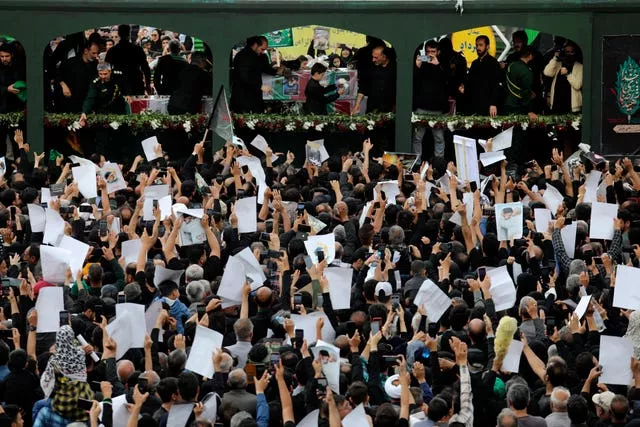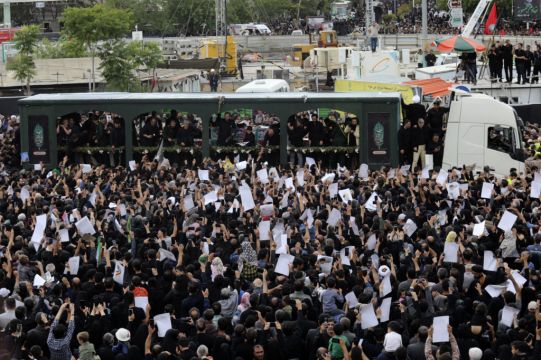Iran was preparing to inter its late president at the holiest site for Shiite Muslims in the Islamic Republic, in a final sign of respect for a protege of the country’s supreme leader killed in a helicopter crash earlier this week.
President Ebrahim Raisi’s burial at the Imam Reza Shrine in Mashhad caps days of processions across much of Iran, seeking to bolster the country’s theocracy after the crash that killed him, the country’s foreign minister and six others.
Hundreds of thousands of people crowded into Mashhad, about 470 miles (750km) east of Iran’s capital, Tehran, many in black and beating their chests and heads in a sign of mourning common in Shiite ceremonies.

A lorry carried his casket down the street, with mourners reaching out to touch it and tossing scarves and other items against it for a blessing.
But the services have not drawn the same crowds as those who gathered for services for Revolutionary Guard General Qassem Soleimani in 2020, killed by a US drone strike in Baghdad.
It is a potential sign of the public’s feelings about Mr Raisi’s presidency during which the government harshly cracked down on all dissent during protests over the 2022 death of Mahsa Amini, detained for allegedly not wearing her mandatory headscarf to the authorities’ liking.

This crackdown, as well as Iran’s struggling economy, have gone unmentioned in the hours of coverage provided by state television and in newspapers. Also never discussed was Mr Raisi’s involvement in the mass execution of an estimated 5,000 dissidents at the end of the Iran-Iraq war.
Prosecutors have warned people against showing any public signs of celebrating Mr Raisi’s death and a heavy security force presence has been seen in Tehran since the crash.
Thousands of people dressed in black gathered on Thursday morning along a main boulevard in the city of Birjand, Mr Raisi’s hometown in Iran’s South Khorasan province along the Afghan border.

Hours later, Mr Raisi’s casket arrived in Mashhad. He will be buried at the Imam Reza Shrine, where Shiite Islam’s eighth imam is buried.
The region has long been associated with Shiite pilgrimage.
In 2016, Iran's supreme leader Ayatollah Khamenei appointed Mr Raisi to run the Imam Reza charity foundation, which manages a vast conglomerate of businesses and endowments in Iran, as well as oversees the shrine. It is one of many charitable foundations fuelled by donations or assets seized after Iran’s 1979 Islamic Revolution.

Mr Raisi will be the first top politician in the country to be buried at the shrine, which represents a major honour for the cleric.
The death of Mr Raisi, foreign minister Hossein Amirabdollahian and six others in the crash on Sunday comes at a politically sensitive moment for Iran, both at home and abroad.
Mr Raisi, who was 63, had been discussed as a possible successor to Iran’s supreme leader, the 85-year-old Mr Khamenei. None of Iran’s living past presidents — other than Mr Khamenei, who was president from 1981 until 1989 — could be seen in state television footage of Wednesday’s prayers. The authorities gave no explanation for their apparent absence.
Iran has set June 28 as the next presidential election. For now, there’s no clear favourite for the position among Iran’s political elite — particularly no-one who is a Shiite cleric, like Mr Raisi.

Acting president Mohammad Mokhber, a relatively unknown first vice president until Sunday’s crash, has stepped into his role and attended a meeting between Mr Khamenei and Hamas leader Ismail Haniyeh on Wednesday.
State media circulated photos on Thursday showing a meeting between Iran’s paramilitary Revolutionary Guard chief and the head of its expeditionary Quds Force and representatives from Hamas, Lebanon’s Hezbollah and Yemen’s Houthi rebels.
This is another sign of Iran’s government’s commitment to those militias it arms against its rivals, Israel and the United States.







